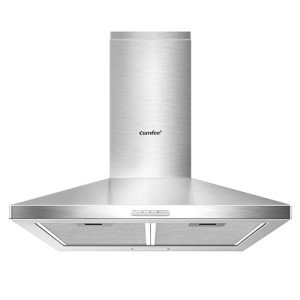
Extractor Hoods
Add a review FollowOverview
-
Founded Date August 27, 2023
-
Sectors Restaurant / Food Services
-
Posted Jobs 0
-
Viewed 4
Company Description
The 12 Most Unpleasant Types Of Cooker Hoods People You Follow On Twitter
The Ultimate Guide to Kitchen Cooker Hoods
When it comes to developing an effective, comfy, and elegant kitchen, one element that often gets overlooked is the cooker hood. An important element in modern kitchens, cooker hoods play a crucial function in keeping air quality while boosting the performance of the cooking location. In this thorough guide, we will explore the importance of cooker hoods, their types, setup ideas, upkeep practices, and responses to regularly asked concerns.

What is a Kitchen Cooker Hood?
A kitchen cooker hood, likewise called a range hood or exhaust hood, is a kitchen device created to ventilate smoke, heat, grease, and steam generated throughout cooking. Cooker hoods can either recirculate air back into the kitchen or vent it outside, depending on the model and installation.
Tables below will provide a detailed contrast of the various types of cooker hoods, their functions, and considerations when selecting the right one for your kitchen.
Types of Cooker Hoods
| Type | Description | Pros | Cons |
|---|---|---|---|
| Wall-Mounted | Installed on the wall above the stove and vented directly outdoors. | Efficient ventilation; conserves area. | Installation might be intricate; limited placement. |
| Island | Suspended from the ceiling over a kitchen island. | Visual appeal; supplies excellent protection. | High installation expense; needs a ceiling hook. |
| Under-Cabinet | Installed underneath cabinets above a stove, perfect for minimal space. | Compact; hassle-free for small kitchens. | May not be as powerful; air blood circulation can be limited. |
| Downdraft | Developed into the counter top, increases when required and pulls back when not in usage. | Streamlined design; reliable for cooktops. | Generally less efficient; can be more pricey. |
| Portable | Lightweight, freestanding systems that can quickly be moved as needed. | Versatile; can be utilized in different locations. | Might not be as effective; restricted by size. |
Key Features to Consider
- Extraction Method: Choose in between ducted (vented) and ductless (recirculating).
- Product: Stainless steel is durable and simple to tidy; glass uses a modern aesthetic.
- Size: Ensure the hood is at least as broad as your cooktop to take full advantage of coverage.
- CFM Rating: The Cubic Feet per Minute (CFM) suggests the ventilation power; normally, 300-600 CFM is perfect for most home kitchens.
- Noise Level: Measured in sones; quieter hoods typically run at lower sone levels.
- Filtering: Filters can be charcoal for ductless systems or metal for ducted systems; ease of cleansing is important.
Value of Kitchen Cooker Hoods
Correct ventilation in a kitchen is essential for numerous factors:
- Improved Air Quality: Cooker hoods help eliminate damaging smoke, steam, and smells created throughout cooking.
- Health Benefits: By getting rid of airborne grease and particulates, they minimize respiratory risks and improve total indoor air quality.
- Preventing Damage: Excess moisture and heat from cooking can cause mold and damage to kitchen surface areas. Cooker hoods help mitigate these concerns.
- Boosted Comfort: An efficient hood can significantly lower kitchen temperatures, making cooking more satisfying.
Setup Tips
Installing a cooker hood is a vital step that requires cautious consideration of several factors:
- Location: Position the hood directly above the cooktop, keeping a height of 24-36 inches.
- Power Source: Ensure there is an available electrical outlet near the installation website for appropriate power supply.
- Ducting: Choose a straight and short duct path to take full advantage of effectiveness; avoid excessive bends.
- Expert Installation: For more intricate designs, hiring a professional installer can guarantee proper performance and security.
- Follow Manufacturer’s Guidelines: Always refer to manufacturer guidelines for particular installation requirements and recommendations.
Maintenance Tips
To maximize the longevity and effectiveness of your cooker hood, routine upkeep is vital. Here are a number of maintenance pointers:
- Clean Regularly: Wipe down the exterior with suitable cleaners to keep surfaces pristine.
- Change Filters: For ducted hoods, tidy or change metal filters every 3-6 months. For ductless hoods, make sure charcoal filters are replaced according to the manufacturer’s instructions.
- Check Ductwork: Inspect vents and ductwork for blockages or accumulation of grease.
- Sound Keeping: If the hood begins making unusual sounds, it might show an issue with the motor or fan. Execute prompt repair work.
- Expert Servicing: Consider a yearly examination by an expert to ensure ideal efficiency.
Regularly Asked Questions (FAQs)
1. How do I choose the ideal size of cooker hood for my kitchen?
To determine the ideal size, determine the width of your cooktop and choose a hood that is at least the same width or broader.
2. Are ducted hoods better than ductless?
Ducted hoods tend to be more effective at ventilating air, while ductless hoods are flexible and much easier to set up.
3. How typically should I clean up the filters?
Metal filters need to be cleaned every couple of months, while charcoal filters must be replaced as per the producer’s recommendations.
4. What is the ideal CFM for my kitchen?
For a basic home kitchen, a CFM score in between 300 to 600 is normally enough. Nevertheless, larger upgrades might require higher CFMs.
5. Can I install a cooker hood myself?
While some designs enable DIY setup, it is typically suggested to work with an expert for more complex ducting and electrical work.
In conclusion, a kitchen cooker hood is more than simply a practical appliance; it is important for maintaining a safe and healthy cooking environment. By comprehending the Types Of Cooker Hood (Dustinjerrett.Top), functions, installation, and maintenance of cooker hoods, house owners can make informed decisions leading to enhanced cooking experiences and kitchen visual appeals. With the best cooker hood, a kitchen can change into an area that integrates design with performance, making sure enjoyable cooking and amusing for many years to come.



